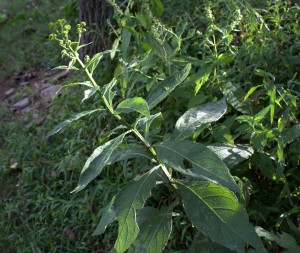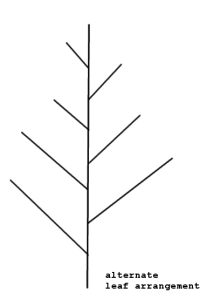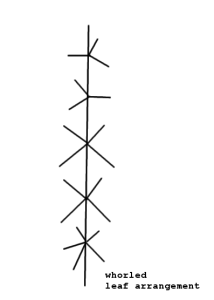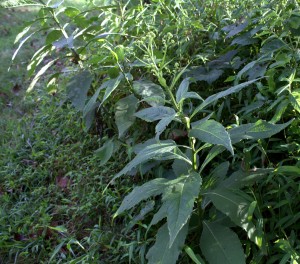Identifying plants can be easy if you know what to look for.
Certain characters, like bloom shape, flower petal count, and leaf type, can help us separate one species of plant from another.
Leaf arrangement, or how leaves are attached to a stem, is another character that may be used to identify plants.
Several plant characteristics should be studied to be able to identify a plant with certainty. Sometimes the species identification is inconclusive at the amateur level and we need to consult the experts in the field.
A great example is a wingstem plant I found that had whorled leaves. All the other wingstem plants in the vicinity appeared to have alternate leaves.

Wingstem, Verbesina alternifolia, is described as having an alternate leaf pattern, so I was curious whether this particular plant was a freak of nature or a different species altogether.
Leaf Arrangement Basics
If you’re not too familiar with leaf arrangement, here’s your primer.
An alternate leaf arrangement is where leaves attach to the stem on different sides and at different heights. Looking at a stem’s side view you’ll see one leaf attached on the right side, the next higher leaf attached on the left side, and the next higher one attached on the right, and so on up the stem.
Oppositely arranged leaves lie directly across from one another, so a leaf attached to the right side is at the same height and directly across from a leaf on the left side. The place where the leaves attach is called a node.
Whorled leaf arrangements are where more than two leaves attach at the same node giving the appearance of a circular arrangement of leaves.
The following line drawings show where leaves are attached in each kind of leaf arrangement.



Whorled Wingstem Is A Freak
Being curious about the one whorled plant, I contacted the Weed Science experts at Virginia Tech and Dr. Michael Flessner kindly investigated the matter for me.
(Click on any image to see a larger view.)

The Herbarium Curator, Dr. Thomas Wieboldt, was able to report back:
“I’ve never seen a Verbesina with whorled leaves, so I had to look into this a bit. Apparently, leaves are occasionally whorled on individual plants, but it is not characteristic of any North American species. In the two photos, one shows whorled leaves except at the upper nodes; the other shows alternate leaves throughout. Based on the shape of the flower heads, I’d say this is Verbesina alternifolia, and is one of the occasional aberrant individuals with whorled leaves.”
So, there we have it. Our little wingstem with the whorled leaves is not your typical wingstem.
And that should teach us a lesson in plant characters. In the field we won’t always have textbook examples because it is the habit of Nature to change.
With respect to leaf arrangement, make sure to look the plant up and down to view the entire length or height before making a decision as to alternate, opposite or whorled.